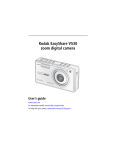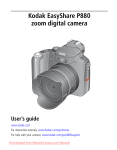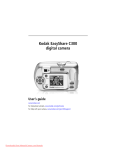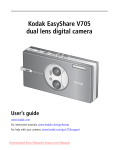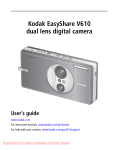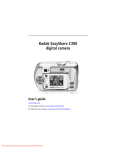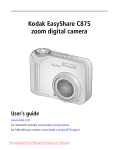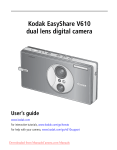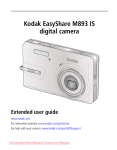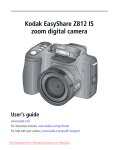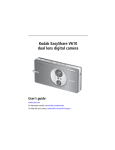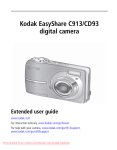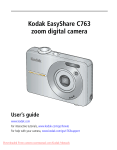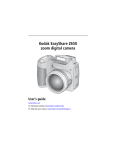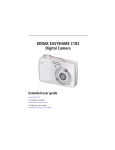Download Kodak V530 User Guide Manual pdf
Transcript
Kodak EasyShare V530 zoom digital camera User’s guide www.kodak.com For interactive tutorials, www.kodak.com/go/howto For help with your camera, www.kodak.com/go/v530support Downloaded From camera-usermanual.com Kodak Manuals Eastman Kodak Company Rochester, New York 14650 © Eastman Kodak Company, 2005 All screen images are simulated. Kodak and EasyShare are trademarks of Eastman Kodak Company. Schneider-Kreuznach and Xenar are trademarks of Jos. Schneider Optische Werke GmbH used under license by Eastman Kodak Company. P/N 4J3465 Downloaded From camera-usermanual.com Kodak Manuals Product features Front view 1 2 3 4 5 6 7 8 13 12 11 9 10 1 Shutter button 8 Video/Self-timer light 2 Flash button 9 DC-In (5V) 3 On/Off button 10 Lens 4 Auto/SCN (scene) mode button 11 Grip 5 Video mode button 12 Flash 6 Favorites mode button 13 Microphone 7 Light sensor www.kodak.com/go/support Downloaded From camera-usermanual.com Kodak Manuals i Product features Back view 2 1 17 3 16 15 4 14 13 5 12 6 11 10 7 9 8 1 Mode/Battery charging lights 10 Dock connector, USB, A/V Out 2 LCD 11 Tripod socket 3 Wide angle/Telephoto button 12 Menu button 4 Speaker 13 Delete button 5 Strap post 14 Close-up/Landscape mode button 6 Slot for optional SD or MMC card 15 OK button 7 Review button 16 8 Share button 17 LCD/Info button 9 Battery compartment ii Downloaded From camera-usermanual.com Kodak Manuals www.kodak.com/go/support Table of contents 1 1 Setting up your camera .........................................................................1 Attaching the strap ....................................................................................... 1 Loading the battery ....................................................................................... 1 Charging the battery ..................................................................................... 2 Turning on the camera .................................................................................. 3 Setting the date/time, first time ..................................................................... 3 Storing pictures on an SD or MMC card ......................................................... 4 2 Taking pictures and videos ....................................................................5 Taking a picture ............................................................................................ 5 Reviewing pictures and videos....................................................................... 9 Deleting pictures and videos........................................................................ 11 3 Transferring and printing pictures .......................................................12 Installing the software................................................................................. 12 Transferring pictures with the photo frame dock 2 ....................................... 13 Transferring pictures with the USB cable...................................................... 13 Also available for transferring...................................................................... 14 Printing pictures.......................................................................................... 14 Dock compatibility for your camera.............................................................. 17 4 Doing more with your camera .............................................................18 Using optical zoom ..................................................................................... 18 Changing the flash settings ......................................................................... 19 Picture-taking modes .................................................................................. 20 Running a slide show .................................................................................. 23 Cropping pictures........................................................................................ 26 Making pictures from a video ...................................................................... 26 Viewing picture/video information ............................................................... 27 Using the histogram to view picture brightness............................................ 27 Copying pictures and videos ........................................................................ 28 www.kodak.com/go/support Downloaded From camera-usermanual.com Kodak Manuals iii Table of contents Using exposure compensation to adjust picture brightness ........................... 28 Changing picture-taking settings ................................................................. 29 Customizing your camera ............................................................................ 33 Pre-tagging for album names ...................................................................... 36 Sharing your pictures................................................................................... 38 5 Troubleshooting ..................................................................................43 Camera problems........................................................................................ 43 Computer/connectivity problems.................................................................. 45 Picture quality problems .............................................................................. 45 Direct printing (PictBridge enabled printer) problems.................................... 47 6 Getting help ........................................................................................48 Helpful links................................................................................................ 48 Telephone customer support ....................................................................... 49 7 Appendix .............................................................................................50 Camera specifications ................................................................................. 50 Flash settings in each mode......................................................................... 53 Storage capacities ....................................................................................... 54 Important safety instructions ....................................................................... 55 Battery life .................................................................................................. 56 Upgrading your software and firmware........................................................ 57 Additional care and maintenance ................................................................ 57 Warranty..................................................................................................... 58 Regulatory compliance ................................................................................ 60 iv Downloaded From camera-usermanual.com Kodak Manuals www.kodak.com/go/support 1 Setting up your camera Attaching the strap Loading the battery Notched corner For information on replacing batteries and extending battery life, see page 56. www.kodak.com/go/support Downloaded From camera-usermanual.com Kodak Manuals 1 Setting up your camera Charging the battery Charge until all 3 battery charging lights are lit (approximately 3 hours). Kodak EasyShare photo frame dock 2 (May be sold separately.) 1 2 Battery charging lights 5-volt AC adapter (included with your camera) NOTE: Use this AC adapter to charge the battery and to power the EasyShare photo frame dock 2. Kodak EasyShare printer dock series 3 or EasyShare camera dock series 3 (May be sold separately. For details, see the dock user’s guide. For dock compatibility, see page 17.) 2 Downloaded From camera-usermanual.com Kodak Manuals www.kodak.com/go/support Setting up your camera Turning on the camera Press the On/Off button to turn the camera on in Auto mode. NOTE: You can also press the Auto/SCN, Video, or Favorites button to turn on the camera in that mode. Setting the date/time, first time 1 At the prompt, press OK. to change. for previous/next field. 2 3 OK to accept. www.kodak.com/go/support Downloaded From camera-usermanual.com Kodak Manuals 3 Setting up your camera Storing pictures on an SD or MMC card Your camera has 16 MB of internal memory. You can purchase an SD or MMC card to conveniently store more pictures and videos. NOTE: We recommend Kodak SD or MMC cards. When using the card for the first time, format it in this camera before taking pictures (see page 35). Notched corner CAUTION: A card can only be inserted one way; forcing it may cause damage. Inserting or removing a card when the ready light is blinking may damage the pictures, the card, or the camera. See page 54 for storage capacities. Purchase SD or MMC cards at a dealer of Kodak products or www.kodak.com/go/v530accessories. 4 Downloaded From camera-usermanual.com Kodak Manuals www.kodak.com/go/support 2 Taking pictures and videos Taking a picture 1 Press the On/Off or the Auto/SCN mode button to turn on the camera. 2 Compose the picture. 3 Press the Shutter button halfway to focus and set exposure. When the AF/AE indicator (on the LCD) turns green, press the Shutter button completely down. Note: Repeatedly press LCD/Info • Status icons on • Status icons off • Histogram on for: AF/AE indicator Taking a video 1 Press the Video mode button. 2 Press the Shutter button completely down and release. To stop recording, press and release the Shutter button again. www.kodak.com/go/support Downloaded From camera-usermanual.com Kodak Manuals 5 Taking pictures and videos Reviewing the picture or video just taken After you take a picture or video, the LCD displays a quickview for approximately 5 seconds. If you press no buttons, the picture/video is saved. Play a video. to adjust volume. Delete Tag a picture/video for email or as a favorite; tag a picture to print. To view pictures and videos anytime, see page 9. Understanding the blur warning icons If the feature is turned on, a picture blur warning icon quickview. is displayed during Green—Picture is sharp enough for an acceptable 4 x 6-inch (10 x 15 cm) print. Yellow—Picture may be sharp enough for an acceptable 4 x 6-inch (10 x 15 cm) print or sharpness is not determined. (You may want to view on a computer monitor before printing.) Red—Picture is not sharp enough for an acceptable 4 x 6-inch (10 x 15 cm) print. White—Print sharpness is still being determined. 6 Downloaded From camera-usermanual.com Kodak Manuals www.kodak.com/go/support Taking pictures and videos Understanding the picture-taking icons In capture mode—no buttons pressed Date stamp Burst Landscape/Close-up Album name Zoom: digital telephoto wide Histogram Flash Picture size Pictures/time remaining Image storage location Video time remaining AF mode Focus zone Exposure metering White balance ISO Camera mode Low battery Exposure compensation In capture mode—shutter pressed halfway Low battery Exposure compensation www.kodak.com/go/support Downloaded From camera-usermanual.com Kodak Manuals 7 Taking pictures and videos Using the auto-focus framing marks (pictures) Framing marks indicate the camera focus area. The camera attempts to focus on foreground subjects, even if the subjects are not centered in the scene. 1 Press the Shutter button halfway. When the framing marks turn green, focus is accomplished. Framing marks Center focus Center wide focus Side focus Center and side focus Left and right focus 2 If the camera is not focusing on the desired subject (or if the framing marks disappear), release the Shutter button and recompose the scene. 3 Press the Shutter button completely down to take the picture. NOTE: Framing marks do not appear in Landscape or Video mode. When you use Focus Zone and set Center Zone, the framing marks are fixed at Center Wide. 8 Downloaded From camera-usermanual.com Kodak Manuals www.kodak.com/go/support Taking pictures and videos Reviewing pictures and videos Press the Review button to view and work with your pictures and videos. 1 Review. (Press again to exit.) 2 for previous/next. Videos: OK Play/pause. Adjust the volume. Press once to play at 2X speed; press again for 4X (during playback). Press once to reverse at 2X speed; press again for 4X (during playback). NOTE: To learn how to choose and view your favorite pictures, see page 40. To save battery power, use an accessory Kodak EasyShare photo frame dock 2, EasyShare dock, or Kodak 5-volt AC adapter. (See www.kodak.com/go/v530accessories.) Magnifying a picture during review W/T magnify 1X - 8X. view other parts of the picture. OK return to 1X. www.kodak.com/go/support Downloaded From camera-usermanual.com Kodak Manuals 9 Taking pictures and videos Viewing multi-up (thumbnails) during review view multi-up thumbnails. highlight a thumbnail. OK view a single picture. Understanding the review icons Pictures Print tag/number of prints Favorite tag Email tag Blur warning Protected Picture/Video number Image storage location Scroll arrows Review Videos Video length Picture/Video number Image storage location Scroll arrows 10 Downloaded From camera-usermanual.com Kodak Manuals Review www.kodak.com/go/support Taking pictures and videos Deleting pictures and videos 1 2 Press Review. for previous/next. 3 Press Delete. 4 Follow the screen prompts. NOTE: To delete protected pictures and videos, remove protection before deleting. Protecting pictures and videos from deletion 1 2 Press Review. for previous/next. 3 Press Menu. 4 Press to highlight Protect, then press OK. The picture or video is protected and cannot be deleted. The Protect icon the protected picture or video. appears with Press the Menu button to exit the menu. CAUTION: Formatting internal memory or an SD or MMC card deletes all (including protected) pictures and videos. (Formatting internal memory also deletes email addresses, album names, and favorites. To restore them, see EasyShare software Help.) www.kodak.com/go/support Downloaded From camera-usermanual.com Kodak Manuals 11 3 Transferring and printing pictures CAUTION: Install Kodak EasyShare software before connecting an EasyShare camera or dock to the computer. Failure to do so may cause the software to load incorrectly. Installing the software 1 Close all software applications that are open on your computer (including anti-virus software). 2 Place the Kodak EasyShare software CD into the CD-ROM drive. 3 Load the software: Windows OS—if the install window does not appear, choose Run from the Start menu and type d:\setup.exe where d is the drive letter that contains the CD. Mac OS X—double-click the CD icon on the desktop, then click the Install icon. 4 Follow the on-screen instructions to install the software. Windows OS—select Complete to automatically install the most commonly used applications. Select Custom to choose the applications you wish to install. Mac OS X—follow the on-screen instructions. NOTE: When prompted, register your camera and software. Registering lets you sign up for information that keeps your system up-to-date. To register later, see www.kodak.com/go/register. For information on the software applications included on the Kodak EasyShare software CD, click the Help button in EasyShare software. 12 Downloaded From camera-usermanual.com Kodak Manuals www.kodak.com/go/support Transferring and printing pictures Transferring pictures with the photo frame dock 2 If you have a Kodak EasyShare photo frame dock 2, use it to transfer pictures. (To purchase accessories, see www.kodak.com/go/v530accessories.) 1 2 Transferring pictures with the USB cable If you do not have an EasyShare dock, use the USB / A/V connector and USB cable model U-8 (may be sold separately). USB / A/V connector NOTE: Visit www.kodak.com/go/howto for an online tutorial on connecting. www.kodak.com/go/support Downloaded From camera-usermanual.com Kodak Manuals 13 Transferring and printing pictures Also available for transferring You can also use these Kodak products to transfer your pictures and videos. ■ Kodak EasyShare camera dock, Kodak EasyShare printer dock (see page 17) ■ Kodak multi-card reader, Kodak SD multimedia card reader-writer Purchase these and other accessories at a dealer of Kodak products or www.kodak.com/go/v530accessories. Printing pictures Printing with a Kodak EasyShare printer dock Dock your camera to the Kodak EasyShare printer dock and print directly—with or without a computer. Purchase this and other accessories at a dealer of Kodak products or www.kodak.com/go/v530accessories. For dock compatibility, see page 17. Direct printing with a PictBridge enabled printer Your camera is compatible with PictBridge technology, so you can print directly to PictBridge enabled printers. You need: ■ Camera with fully charged battery, or with optional Kodak 5-volt AC adapter ■ PictBridge enabled printer ■ USB cable 14 Downloaded From camera-usermanual.com Kodak Manuals www.kodak.com/go/support Transferring and printing pictures Connecting the camera to a PictBridge enabled printer 1 Turn off the camera and printer. 2 Optional: If you have a Kodak 5-volt AC adapter (optional accessory), plug it into the camera and into an electrical outlet. 3 Connect the appropriate USB cable from the camera to the printer. See your printer user guide for details or www.kodak.com/go/v530accessories to order cables. Printing from a PictBridge enabled printer 1 Turn on the printer. Turn on the camera. The PictBridge logo is displayed, followed by the current picture and menu. (If no pictures are found, a message is displayed.) If the menu interface turns off, press any button to redisplay it. 2 Press to choose a printing option, then press the OK button. Current Picture—Press to choose a picture. Choose the number of copies. Tagged Pictures—If your printer is capable, print pictures that you tagged for printing and choose a print size. Index Print—Print thumbnails of all pictures. (This option requires one or more sheets of paper.) If the printer is capable, choose a print size. All Pictures—Print all pictures in internal memory, on a card, or in Favorites. Choose the number of copies. Image Storage—Access internal memory, a card, or Favorites. NOTE: During direct printing, pictures are not permanently transferred or saved to the printer. To transfer pictures to your computer, see page 12. In Favorites mode, the current favorite picture is displayed. www.kodak.com/go/support Downloaded From camera-usermanual.com Kodak Manuals 15 Transferring and printing pictures Disconnecting the camera from a PictBridge enabled printer 1 Turn off the camera and printer. 2 Disconnect the USB cable from the camera and the printer. Using a printer that is not PictBridge enabled For details on printing pictures from your computer, click the Help button in EasyShare software. Ordering prints online Kodak EasyShare gallery (www.kodakgallery.com) is one of the many online print services offered in EasyShare software. You can easily: ■ Upload your pictures. ■ Edit, enhance, and add borders to your pictures. ■ Store pictures, and share them with family and friends. ■ Order high-quality prints, photo greeting cards, frames, and albums—and have them delivered to your door. Printing from an optional SD or MMC card ■ Automatically print tagged pictures when you insert your card into a printer with an SD/MMC card slot. See your printer user’s guide for details. ■ Make prints at an SD/MMC card-capable Kodak picture maker. (Contact a location prior to visiting. See www.kodak.com/go/picturemaker.) ■ Take the card to your local photo retailer for professional printing. 16 Downloaded From camera-usermanual.com Kodak Manuals www.kodak.com/go/support Transferring and printing pictures Dock compatibility for your camera Dock Docking configuration ■ Kodak EasyShare photo See page 13. frame dock 2 ■ Kodak EasyShare printer dock series 3 and EasyShare camera dock series 3 Custom dock insert Dock Kodak EasyShare: Custom dock insert ■ printer dock ■ printer dock plus ■ printer dock 6000 Kodak dock adapter D-22 ■ camera dock 6000 Dock Other docks: Not compatible ■ printer dock 4000 ■ camera dock II ■ LS420, LS443 camera dock Purchase camera docks, printer docks, and other accessories at a dealer of Kodak products or www.kodak.com/go/v530accessories. www.kodak.com/go/support Downloaded From camera-usermanual.com Kodak Manuals 17 4 Doing more with your camera Using optical zoom Use optical zoom to get up to 3X closer to your subject. Optical zoom is effective when the lens is no closer than 24 in. (60 cm) to the subject or 5 in. (13 cm) in Close-up mode. 1 Use the LCD to frame your subject. 2 Press Telephoto (T) to zoom in. Press Wide Angle (W) to zoom out. The zoom indicator shows zoom status. 3 Take the picture or video. Zoom indicator D T W Digital zoom Optical zoom Using digital zoom Use digital zoom in any Still mode to get up to 4X magnification beyond optical zoom. 1 Press Telephoto (T) to the optical zoom limit (3X). Release the button, then press it again. 2 Take the picture. NOTE: You cannot use digital zoom for video recording. You may notice decreased image quality when using digital zoom. The blue slider on the zoom indicator pauses and turns red when the picture quality reaches the limit for an acceptable 4 x 6-in. (10 x 15 cm) print. 18 Downloaded From camera-usermanual.com Kodak Manuals www.kodak.com/go/support Doing more with your camera Changing the flash settings Press the flash button repeatedly to scroll through flash modes. The current flash mode is shown in the LCD status area. Flash modes Flash fires Auto Flash When the lighting conditions require it. Fill Every time you take a picture, regardless of the lighting conditions. Use when the subject is in shadow or is “backlit” (when light is behind the subject). In low light, hold the camera steady or use a tripod. Red-eye Once, so the subject’s eyes become accustomed to the flash, then fires again when the picture is taken. (If the lighting conditions require flash but do not require Red-eye reduction, the flash may fire only once.) Off Never For flash settings in each mode, see page 53. www.kodak.com/go/support Downloaded From camera-usermanual.com Kodak Manuals 19 Doing more with your camera Picture-taking modes Choose the mode that best suits your subjects and surroundings. Use this mode For Auto General picture-taking—offers an excellent balance of image quality and ease of use. Scene Point-and-shoot simplicity when taking pictures under special conditions. (See page 21.) Video Capturing video with sound. (See page 5.) Favorites Viewing favorite pictures. (See page 38.) Press a button to choose a mode. Use this mode For Landscape Far-away scenes. The camera uses infinity auto-focus. Auto-focus framing marks are not available in Landscape. Close-up Close range. Use available light instead of flash, if possible. The camera automatically sets the focus distance depending on the zoom position. Press until the Close-up or Landscape icon appears in the LCD status area. 20 Downloaded From camera-usermanual.com Kodak Manuals www.kodak.com/go/support Doing more with your camera Scene (SCN) modes 1 Press the Auto/SCN button until the Scene icons appear on the LCD. 2 Press to view scene mode descriptions. NOTE: If the description turns off, press the OK button. 3 Press the OK button to choose a Scene mode. Use this SCN mode For Camera pre-settings Portrait Full-frame portraits of people. Subject is sharp and the background is indistinct. Position your subject at least 6 ft (2 m) away and fill the frame with a head and shoulder pose. Use Telephoto to exaggerate background blur. Sport Subjects that are in motion. Fast shutter speed, Multi-Pattern Exposure Metering Landscape Far-away scenes. The camera uses infinity auto-focus. Auto-focus framing marks are not available in Landscape. Close-up Close range. Use available The camera automatically sets the focus light instead of flash if distance depending on the zoom position. possible. Night Portrait Reduces red-eye of people Multi-Pattern Exposure Metering, in night scenes or low-light Multi-Zone Focus, Red-eye flash conditions. Place the camera on a flat, steady surface or use a tripod. Night Distant scenery at night. Landscape Flash does not fire. Place the camera on a flat, steady surface or use a tripod. Infinity Focus, Center-Weight Metering, Daylight White balance, Flash Off, maximum 2-second shutter speed www.kodak.com/go/support Downloaded From camera-usermanual.com Kodak Manuals 21 Doing more with your camera Use this SCN mode For Camera pre-settings Snow Bright snow scenes. Center-Weight Metering, Multi-Zone Focus, +1 Exposure Compensation Beach Bright beach scenes. Center-Weight Metering, Daylight White Balance, +1 Exposure Compensation Text Documents. Macro Focus, Center-Weight Metering, Multi-Zone Focus, +1 Exposure Compensation Fireworks Flash does not fire. Place the camera on a flat, steady surface or use a tripod. 2-second exposure, Infinity Focus, Center-Weight Metering, Daylight White Balance Flower Close-ups of flowers or other small subjects in bright light. Macro Focus, Daylight White Balance, Center-Zone Focus, Center-Weight Metering Manner/ Museum No sounds, no flash, Multi-Pattern Quiet occasions, like a wedding or lecture. Flash Exposure Metering, Multi-Zone Focus and sound are disabled. SelfPortrait Close-ups of yourself. Macro Focus, Multi-Pattern Exposure Assures proper focus and Metering, Multi-Zone Focus, Red-eye Flash minimizes red-eye. Party People indoors. Minimizes Multi-Pattern Exposure Metering, red-eye. Multi-Zone Focus, Red-eye Flash Children Action pictures of children Multi-Pattern Exposure Metering, in bright light. Multi-Zone Focus Backlight Subjects that are in shadow or “backlit” (when light is behind the subject). Multi-Pattern Exposure Metering, Multi-Zone Focus, Fill-Flash 22 Downloaded From camera-usermanual.com Kodak Manuals www.kodak.com/go/support Doing more with your camera Use this SCN mode For Camera pre-settings Panning Shot Shooting a fast-moving subject. The background gives the sense of movement, while the subject appears still. Shutter speed > 1/180 sec., Multi-Zone Focus, Multi-Pattern Exposure Metering Candle Light Subjects illuminated by candle light. Multi-Pattern Exposure Metering, MultiZone Focus, Daylight White Balance Sunset Subjects at dusk. Multi-Pattern Exposure Metering, MultiZone Focus, Daylight White Balance Custom Choosing your own settings. Settings are saved, even after the camera is turned off. (To reset, see page 32.) Running a slide show Use the Slide Show to display your pictures and videos on the LCD. NOTE: If you have an EasyShare photo frame dock 2, see page 25. Starting the slide show To save battery power, use an optional Kodak 5V AC adapter. 1 Press the Review button, then press the Menu button. 2 Press to highlight Slide Show , then press the OK button. 3 Press to highlight Begin Show, then press the OK button. Each picture and video is displayed once. To interrupt the Slide Show, press the OK button. www.kodak.com/go/support Downloaded From camera-usermanual.com Kodak Manuals 23 Doing more with your camera Changing the slide show display interval The default interval setting displays each picture for 5 seconds. You can set the display interval from 3 to 60 seconds. 1 On the Slide Show menu, press button. to highlight Interval, then press the OK 2 Select a display interval. To scroll through the seconds quickly, press and hold . 3 Press the OK button. The interval setting remains until you change it. Running a continuous slide show loop When you turn on Loop, the slide show is continuously repeated. 1 On the Slide Show menu, press to highlight Loop, then press the OK button. 2 Press to highlight On, then press the OK button. The slide show repeats until you press the OK button or until battery power is exhausted. The Loop feature remains until you change it. Choosing a slide show transition 1 On the Slide Show menu, press button. 2 Press to highlight Transition, then press the OK to select a transition, then press the OK button. 24 Downloaded From camera-usermanual.com Kodak Manuals www.kodak.com/go/support Doing more with your camera Displaying pictures and videos on a television You can display pictures and videos on a television, computer monitor, or any device equipped with a video input. To connect the camera to a television, use the USB / A/V connector and A/V cable (may be sold separately). NOTE: Ensure that the Video Out setting (NTSC or PAL) is correct (see page 34). The slide show stops if you connect or disconnect the cable while the slide show is running. (Image quality on a television screen may not be as good as on a computer monitor or when printed.) USB / A/V connector Running a slide show with the photo frame dock 2 Your package may include an EasyShare photo frame dock 2. See your packaging for details. (To purchase accessories, see www.kodak.com/go/v530accessories.) 1 2 www.kodak.com/go/support Downloaded From camera-usermanual.com Kodak Manuals 25 Doing more with your camera Cropping pictures 1 2 3 Press Review. to locate a picture to crop. Press Menu, choose Crop , then press OK. 4 Press Telephoto (T) to zoom in, or to move the crop box. 5 Follow the screen prompts. The picture is copied, then cropped. The original picture is saved. A cropped picture cannot be cropped again on the camera. Cropped pictures take up space in internal memory or on a card. Press the Menu button to exit the menu. Making pictures from a video 1 2 Press Review. to locate a video. 3 Press Menu, choose Make Picture 4 , then press OK. Follow the screen prompts. A picture is created. The original video is saved. Pictures take up space in internal memory or on a card. Press the Menu button to exit the menu. 26 Downloaded From camera-usermanual.com Kodak Manuals www.kodak.com/go/support Doing more with your camera Viewing picture/video information 1 Press Review. for: 2 Repeatedly press LCD/Info • Status icons on • Status icons off • Histogram • Picture/video info To exit Review, press the Review button. Using the histogram to view picture brightness The histogram shows the distribution of the subject’s brightness. If the peak is to the right of the graph, the subject is bright; if it’s to the left, the subject is dark. Optimal exposure is achieved when the peak is in the middle of the histogram. To turn on the histogram in Capture mode or in Review, press the LCD/Info button until the histogram appears. www.kodak.com/go/support Downloaded From camera-usermanual.com Kodak Manuals 27 Doing more with your camera Copying pictures and videos You can copy pictures and videos from a card to internal memory or from internal memory to a card. Before you copy, make sure that: ■ A card is inserted in the camera. ■ The camera’s picture storage location is set to the location from which you are copying. See page 33. Copy pictures or videos: 1 Press the Review button, then press the Menu button. 2 Press to highlight Copy 3 Press to highlight an option. , then press the OK button. 4 Press the OK button. NOTE: Pictures and videos are copied, not moved. To remove pictures and videos from the original location after copying, delete them (see page 11). Tags that you applied for print, email, and favorites are not copied. Protection settings are not copied. To apply protection to a picture or video, see page 11. Using exposure compensation to adjust picture brightness You can adjust exposure compensation to make your pictures darker or lighter. to increase exposure compensation to decrease exposure compensation The exposure compensation level is shown on the LCD brighter or dimmer. 28 Downloaded From camera-usermanual.com Kodak Manuals and the LCD gets www.kodak.com/go/support Doing more with your camera Changing picture-taking settings You can change settings to get the best results from your camera. (Some settings are unavailable in some modes.) 1 Press the Menu button. 2 Press to highlight a setting, then press the OK button. 3 Choose an option, then press the OK button. Setting Icon Self-timer A picture is taken 10 seconds after the Shutter button is pressed. (Place camera on a tripod or flat surface.) Burst Camera takes up to 5 pictures while the Shutter button is pressed. Capture an expected event, such as a person swinging a golf club. Options Off (default) On Press the Shutter button halfway, then completely down. To stop the Self-timer before the picture is taken, press the Shutter button all the way down. (Use the Menu button to cancel the Self-timer.) Use the same procedure to take a self-timer video, but press the Shutter button completely down. NOTE: The video stops when no storage space remains. NOTE: Press the Shutter button halfway to focus and set exposure. Press the Shutter button completely down and hold it to take pictures. The camera stops taking pictures when you release the Shutter button, when the pictures are taken, or when there is no more storage space. During quickview, you can delete all pictures in the burst series. To delete selectively, do so in Review (see page 11). www.kodak.com/go/support Downloaded From camera-usermanual.com Kodak Manuals 29 Doing more with your camera Setting Icon Options Picture Size Choose a picture resolution. This setting remains until you change it. 5.0 MP (default)—for printing up to 20 x 30 in. (50 x 76 cm); pictures are highest resolution and largest file size. 4.4 MP (3:2)— ideal for printing 4 x 6 in. (10 x 15 cm) prints without cropping. Also for printing up to 20 x 30 in. (50 x 76 cm) 4.0 MP— for printing up to 20 x 30 in. (50 x 76 cm); pictures are medium resolution with smaller file size. 3.1 MP—for printing up to 11 x 14 in. (28 x 36 cm); pictures are medium resolution with smaller file size. 1.8 MP—for printing 4 x 6 in. (10 x 15 cm) prints, emailing, Internet, screen display, or for conserving space. Video Size Choose a video resolution. This setting remains until you change it. 640 x 480 (default) 320 x 240 White Balance Choose your lighting condition. This setting remains until you change modes or turn off the camera. Auto (default)—automatically corrects white balance. Ideal for general picture taking. Daylight—for pictures in natural lighting. Tungsten—corrects the orange cast of household light bulbs. Ideal for indoor pictures under tungsten or halogen lighting without flash. Fluorescent—corrects the green cast of fluorescent lighting. Ideal for indoor pictures under fluorescent lighting without flash. Open Shade—for pictures in shade in natural lighting. Available in Auto and SCN-Custom mode. 30 Downloaded From camera-usermanual.com Kodak Manuals www.kodak.com/go/support Doing more with your camera Setting ISO Speed Control the sensitivity of the camera sensor. This setting remains until you change modes or turn off the camera. Icon Options ISO Auto (default) ISO 80, 100, 200, 400, 800 (800 available only in 1.8 MP picture size.) Color Mode Choose color tones. This setting remains until you change modes or turn off the camera. High Color Natural Color (default) Low Color Black & White Sepia—for a reddish-brown, antique look. NOTE: EasyShare software also lets you change a color picture to black-and-white or sepia. Unavailable in Video mode. Sharpness Control picture sharpness. This setting remains until you change it. High Normal (default) Low Exposure Metering Evaluate light levels at specific areas of a scene. This setting remains until you change modes or turn off the camera. Multi-pattern (default)—evaluates lighting conditions throughout the image to give an optimum picture exposure. Ideal for general picture taking. Center-weight—evaluates the lighting conditions of the subject centered in the lens. Ideal for backlit subjects. Center-spot—similar to Center-weight, except the metering is concentrated on a smaller area of the subject centered in the lens. Ideal when you need an exact exposure of a specific area in the picture. www.kodak.com/go/support Downloaded From camera-usermanual.com Kodak Manuals 31 Doing more with your camera Setting Icon Options AF Control Choose an auto-focus setting. This setting remains until you change it. Continuous AF—because the camera is always focusing, there is no need to press the Shutter button halfway down to focus. Single AF (default)—uses TTL-AF when the Shutter button is pressed halfway down. Focus Zone Select a large or concentrated area of focus. This setting remains until you change it. Multi-zone (default)—evaluates 3 zones to give an even picture focus. Ideal for general picture taking. Center-zone—evaluates the small area centered in the lens. Ideal when precise focus of a specific area in the picture is needed. NOTE: For the best pictures, the camera is set to Multi-zone when in Landscape mode. Long Time Exposure Choose how long the shutter stays open. 0.5, 0.7, 1, 1.5, 2, 3, 4, 6, or 8 seconds Reset to Default All picture-taking settings return to their default. Available only in SCN-Custom mode. Set Album Choose Album names. This setting remains until you change it. You can apply different Set Album choices to videos and to pictures. On Off (default) Pre-select album names before you take pictures or videos. Then, all the pictures or videos you take are tagged with those album names. See page 36. Video Length Choose video record length. This setting remains until you change it. Continuous (default) 5 sec. 15 sec. 30 sec. Image Stabilizer Improve video stability. On (default) Off 32 Downloaded From camera-usermanual.com Kodak Manuals www.kodak.com/go/support Doing more with your camera Setting Icon Options Image Storage Choose a storage location for pictures and videos. This setting remains until you change it. Auto (default)—the camera uses the card if one is in the camera. If not, the camera uses internal memory. Internal Memory—the camera always uses internal memory, even if a card is installed. Setup Menu Choose additional settings. See Customizing your camera. Customizing your camera Use Setup to customize your camera settings. 1 In any mode, press the Menu button. 2 Press to highlight Setup , then press the OK button. 3 Press to highlight the setting you wish to change, then press the OK button. 4 Choose an option, then press the OK button. Setting Options Return to previous menu. Camera Sounds Choose sound effects. Theme—applies the same sound effect set to all functions. Individual—choose a sound effect for each function. Sound Volume Off High Medium Low (default) www.kodak.com/go/support Downloaded From camera-usermanual.com Kodak Manuals 33 Doing more with your camera Setting Options LCD Brightness Choose LCD brightness. Auto Power Save High Power (default) LCD Dimmer Choose inactivity time until LCD dims. 30 seconds 20 seconds 10 seconds (default) Off (no dimming) Auto Power Off 10 minutes (default) Choose inactivity time until camera turns 5 minutes off. 3 minutes 1 minutes Date & Time See page 3. NTSC (default)—used in North America and Video Out Choose the regional setting that lets you Japan; most common format. PAL—used in Europe and China. connect the camera to a television or other external device. Photo frame Choose EasyShare photo frame dock 2 settings. Interval (between slide show frames) Loop (On/Off, for slide show) Transition (between slide show frames) Image Source (Auto/Internal/Favorites) Run Time (for slide show) Orientation Sensor On (default) Orient pictures so that they are displayed Off with the correct side up. On Transfer—sets Orientation Sensor on camera LCD to Off. When picture is transferred to the computer, it is rotated to the proper orientation. 34 Downloaded From camera-usermanual.com Kodak Manuals www.kodak.com/go/support Doing more with your camera Setting Options Red Eye Preflash On—red-eye flash fires before the picture is taken. Choose if a pre-flash fires when the flash Off (default)—red-eye flash does not fire. is in Red-eye mode. NOTE: The camera automatically corrects red-eye, even if the Red Eye Preflash is set to Off. Date Stamp Imprint the date on pictures. Choose a date option, or turn off the feature. (Default is off.) Video Date Display Display Date/Time at the start of video playback. On (default)— choose from date formats. Off Video Print Nine frames are taken from each new video to make a 9-up picture. On (default) Off Blur Warning On Off (default) See page 6. Language Choose your language. Format Memory Card—deletes everything on the card; formats the card. Cancel—exits without making a change. Internal Memory—deletes everything in internal memory including email addresses, album names, and favorites; formats the internal memory. CAUTION: Formatting deletes all pictures and videos, including those that are protected. Removing a card during formatting may damage the card. About View camera information. www.kodak.com/go/support Downloaded From camera-usermanual.com Kodak Manuals 35 Doing more with your camera Pre-tagging for album names Use the Set Album (Still or Video) feature to pre-select album names before you take pictures or videos. Then, all the pictures or videos you take are tagged with those album names. First—on your computer Use the EasyShare software that came with your camera to create album names on your computer. The next time you connect the camera to the computer, up to 32 album names are copied to the camera’s internal memory. See Kodak EasyShare software Help for details. Second—on your camera 1 In any mode, press the Menu button. 2 Press to highlight Set Album , then press the OK button. 3 Press to highlight an album name, then press the OK button. Repeat to mark pictures or videos for albums. 4 Highlight Exit, then press the OK button. 5 Press the Menu button to exit the menu. Your selections are saved. Your album selection is displayed on the LCD. A plus (+) after the album name means more than one album is selected. Third—transfer to your computer When you transfer the tagged pictures or videos to your computer, Kodak EasyShare software opens and categorizes your pictures in the appropriate album. See EasyShare software Help for details. 36 Downloaded From camera-usermanual.com Kodak Manuals www.kodak.com/go/support Doing more with your camera Tagging pictures/videos for albums Use the Album feature in Review mode to tag the pictures and videos in your camera with album names. First—on your computer Use Kodak EasyShare software to create album names on your computer, then copy up to 32 album names to the camera’s internal memory. See EasyShare software Help for details. Second—on your camera 1 Press the Review button, then locate the picture or video. 2 Press the Menu button. 3 Press to highlight Album , then press the OK button. 4 Press to highlight an album name, then press the OK button. To add other pictures to the same album, press to scroll through the pictures. When the picture you want is displayed, press the OK button. To add the pictures to more than one album, repeat step 4 for each album. The album name appears with the picture. A plus (+) after the album name means the picture was added to more than one album. To remove a selection, highlight an album name and press the OK button. To remove all album selections, select Clear All. Third—transfer to your computer When you transfer the tagged pictures and videos to your computer, the Kodak EasyShare software opens and categorizes your pictures and videos in the appropriate album. See Kodak EasyShare software Help for details. www.kodak.com/go/support Downloaded From camera-usermanual.com Kodak Manuals 37 Doing more with your camera Sharing your pictures Press the Share button to tag your pictures and videos. When they are transferred to your computer, you can share them. Press the Share button to tag pictures/videos: ■ Any time. (The most recent picture/video taken is then displayed.) ■ Just after you take a picture/video, during quickview (see page 6). ■ After pressing the Review button (see page 9). Tagging pictures for printing 1 Press the Share button. Press 2 Press to highlight Print to locate a picture. , then press the OK button.* 3 Press to select the number of copies (0-99). Zero removes the tag for that picture. The Print icon appears in the status area. The default quantity is one. 4 Optional: You can apply a print quantity to other pictures. Press to locate a picture. Keep the print quantity as is, or press to change it. Repeat this step until the desired print quantity is applied to the pictures. 5 Press the OK button. Then press the Share button to exit the menu. * To tag all pictures in the storage location, highlight Print All, press the OK button, then indicate the number of copies. Print All is not available in quickview. To remove print tagging for all pictures in the storage location, highlight Cancel Prints, then press the OK button. Cancel Prints is not available in quickview. Printing tagged pictures When you transfer the tagged pictures to your computer, the EasyShare software print screen opens. For details on printing, click the Help button in the EasyShare software. For more information on printing from your computer, printer dock, PictBridge enabled printer, or card, see page 14. NOTE: For the best 4 x 6 in. (10 x 15 cm) prints, use the 4.4 MP (3:2) print quality setting. See page 30. 38 Downloaded From camera-usermanual.com Kodak Manuals www.kodak.com/go/support Doing more with your camera Tagging pictures and videos for emailing First—on your computer Use Kodak EasyShare software to create an email address book on your computer. Then, copy up to 32 email addresses to the camera’s internal memory. For details, click the Help button in the Kodak EasyShare software. Second—tag pictures/videos on your camera 1 Press the Share button. Press to locate a picture/video. 2 Press to highlight Email , then press the OK button. The Email icon appears in the status area. 3 Press to highlight an email address, then press the OK button. To tag other pictures/videos with the same address, press them. When the picture you want is displayed, press OK. to scroll through To send the pictures/videos to more than one address, repeat step 3 for each address. Selected addresses are checked. 4 To remove a selection, highlight a checked address and press the OK button. To remove all email selections, highlight Clear All. 5 Press to highlight Exit, then press the OK button. The Email icon appears in the status area. 6 Press the Share button to exit the menu. Third—transfer and email When you transfer the tagged pictures/videos to your computer, the Email screen opens and lets you send them to the addresses you specified. For details, click the Help button in the Kodak EasyShare software. www.kodak.com/go/support Downloaded From camera-usermanual.com Kodak Manuals 39 Doing more with your camera Tagging pictures as favorites You can preserve your favorite pictures in the Favorites section of your camera’s internal memory, then share them with friends and family. NOTE: When you transfer pictures from your camera to your computer, all pictures (including favorites) are stored on your computer at full size. Favorite pictures - smaller copies of your originals - are loaded back to your camera, so you can share and enjoy more. Share your favorite pictures in 3 easy steps: 1. Tag pictures as 1 Press the Share button. Press favorites 2 Press to highlight Favorite to locate a picture. , then press the OK button. The Favorite icon appears in the status area. To remove the tag, press the OK button again. 1 To enjoy full functionality, load and use the EasyShare software that 2. Transfer was packaged with this camera. (See page 12.) pictures to your computer 2 Connect the camera to the computer using a USB cable model U-8 (see page 13) or an EasyShare dock. The first time you transfer pictures, the software helps you make choices about your favorite pictures. Then, your pictures are transferred to the computer. Favorite pictures (smaller versions of the originals) are loaded to the Favorites section of your camera’s internal memory. 1 Press the Favorites button. 3. View favorites on your camera 2 Press to scroll through favorites. NOTE: The camera holds a limited number of favorites. Use Camera Favorites in EasyShare software to customize the size of your camera Favorites section. Videos tagged as favorites remain in the Favorites folder in the EasyShare software. For more information, click the Help button in EasyShare software. 40 Downloaded From camera-usermanual.com Kodak Manuals www.kodak.com/go/support Doing more with your camera Optional settings In Favorites mode, press the Menu button to access optional settings. Slide Show (page 23) Remove all favorites (page 41) Multi-up (page 10) Setup Menu (page 33) NOTE: Pictures taken at the 4.4 MP (3:2) quality setting are displayed at a 3:2 aspect ratio with a black bar at the top of the screen. Removing all favorites from your camera 1 Press the Favorites button. 2 Press the Menu button. 3 Highlight , then press the OK button. All pictures stored in the Favorites section of internal memory are removed. Favorites are restored the next time you transfer pictures to the computer. 4 Press the Menu button to exit the menu. Preventing favorites from transferring to the camera 1 Open the Kodak EasyShare software. Click the My Collection tab. 2 Go to the Albums view. 3 Click the Camera Favorites Album for your camera. 4 Click Remove Album. The next time you transfer pictures from your camera to the computer, use the Camera Favorites Wizard/Assistant to either recreate your Camera Favorites Album or to turn off the Camera Favorites feature. www.kodak.com/go/support Downloaded From camera-usermanual.com Kodak Manuals 41 Doing more with your camera Printing and emailing favorites 1 Press the Favorites button. Press to locate a picture. 2 Press the Share button. 3 Highlight Print or Email , then press the OK button. NOTE: Favorites that were taken on this camera (not imported from another source) are good for prints up to 4 x 6 in. (10 x 15 cm). 42 Downloaded From camera-usermanual.com Kodak Manuals www.kodak.com/go/support 5 Troubleshooting Camera problems Status Solution Camera does not turn on ■ Make sure the correct battery type is installed (page 56). ■ Insert a charged battery. Camera does not turn ■ Connect the camera to a Kodak 5-volt AC adapter, then try again. off and the lens does not retract Camera buttons and controls do not function Lens does not extend ■ Make sure the battery is charged. when camera turns on ■ Turn the camera off, then on again. (The lens does not extend in or does not retract Favorites mode.) ■ If the problem still exists, get help (page 48). In Review, a blue or black screen is displayed instead of a picture ■ Transfer all pictures to the computer (page 12). ■ Take another picture. If the problem continues, change the image storage location to internal memory (page 33). Pictures remaining ■ Continue taking pictures. The camera is operating normally. number does not (The camera estimates the number of pictures remaining after each decrease after taking a picture is taken, based on picture size and content.) picture Picture orientation is not accurate ■ Set the Orientation Sensor to ON (page 34). Flash does not fire ■ Check the flash setting, and change as needed (page 19). NOTE: The flash does not fire in all modes. www.kodak.com/go/support Downloaded From camera-usermanual.com Kodak Manuals 43 Troubleshooting Status Solution Storage location is almost or entirely full ■ Transfer the pictures to the computer (page 12). ■ Delete pictures from the card or insert a new card. ■ Change the image storage location to internal memory (page 33). Battery life is short ■ Make sure the correct battery type is installed (page 56). ■ Wipe the contacts with a clean, dry cloth before inserting a battery in the camera. ■ Insert a new or charged battery (page 1). You cannot take a picture ■ Turn the camera off, then on again. Make sure the camera is not in Favorites mode. ■ Depress the Shutter button all the way (page 5). ■ Insert a new or charged battery (page 1). ■ Wait until the AF/AE indicator turns green before taking another picture. ■ Memory is full. Transfer pictures to the computer (page 12), delete pictures (page 11), change image storage location, or insert another card. Error message appears ■ Turn the camera off, then on again. on LCD ■ Remove the memory card. ■ Remove the battery. Wipe the contacts with a clean, dry cloth. ■ Insert a new or charged battery. ■ If the problem still exists, get help (page 48). ■ Card may be corrupted. Format the card in the camera (page 35). Memory card not recognized or camera ■ Use another memory card. freezes with card. 44 Downloaded From camera-usermanual.com Kodak Manuals www.kodak.com/go/support Troubleshooting Computer/connectivity problems Status Solution Computer does not communicate with the camera ■ Insert a charged battery (page 1). ■ Turn on the camera. ■ Make sure the USB cable model U-8 is connected to the camera and the computer (page 13). (If using an EasyShare dock, check all cable connections. Make sure the camera is seated on the dock.) ■ Make sure the EasyShare software is installed (page 12). Pictures do not transfer to computer ■ Click the Help button in the EasyShare software. Slide Show does not run on an external video device ■ Adjust the camera Video Out setting (NTSC or PAL, page 34). ■ Make sure the external device settings are correct. (See the device’s user’s guide). Picture quality problems Status Solution Picture is not clear ■ To automatically set exposure and focus, press the Shutter button halfway. When the AF/AE indicator turns green, press the Shutter button completely down to take the picture. ■ Clean the lens (page 57). ■ Make sure the camera is not in Close-up mode if you are more than 21 in. (0.7 m) from your subject. ■ Place the camera on a flat, steady surface or use a tripod (especially in high-zoom settings or in low light). www.kodak.com/go/support Downloaded From camera-usermanual.com Kodak Manuals 45 Troubleshooting Status Solution Picture is too dark ■ Reposition the camera for more available light. ■ Use Fill flash (page 19) or change your position so light is not behind the subject. ■ Move so that the distance between you and the subject is within the effective flash range (page 51). ■ To automatically set exposure and focus, press the Shutter button halfway. When the AF/AE indicator turns green, press the Shutter button completely down to take the picture. Picture is too light ■ Reposition the camera to reduce the amount of available light. ■ Turn the flash off (page 19). ■ Move so that the distance between you and the subject is within the effective flash range (page 51). ■ To automatically set exposure and focus, press the Shutter button halfway. When the AF/AE indicator turns green, press the Shutter button completely down to take the picture. ■ In Auto and SCN-Custom modes, adjust the Exposure Compensation (page 28). 46 Downloaded From camera-usermanual.com Kodak Manuals www.kodak.com/go/support Troubleshooting Direct printing (PictBridge enabled printer) problems Status Solution Cannot locate desired picture. ■ Turn on the camera. Make sure the camera is not in Favorites mode. ■ Use the Direct print menu to change the image storage location. The Direct print menu interface turns off. ■ Press any camera button to redisplay the menu. Cannot print pictures. ■ Make sure there is a connection between the camera and the printer (page 13). ■ Make sure the printer and the camera have power. Camera or printer display an error message. ■ Follow the prompts to resolve the issue. www.kodak.com/go/support Downloaded From camera-usermanual.com Kodak Manuals 47 6 Getting help Helpful links Camera Get support for your product (FAQs, troubleshooting www.kodak.com/go/v530support information, arrange for repairs, etc.) Purchase camera accessories (camera docks, printer www.kodak.com/go/v530accessories docks, lenses, cards, etc.) Download the latest camera firmware and software www.kodak.com/go/v530downloads See online demonstrations of your camera www.kodak.com/go/howto Software Get information on EasyShare software www.kodak.com/go/easysharesw (or click the Help button in the EasyShare software) Get help with the Windows operating system and working with digital pictures www.kodak.com/go/pcbasics Other Get support for cameras, software, accessories, more www.kodak.com/go/support Get information on Kodak EasyShare printer docks www.kodak.com/go/printerdocks Get information on Kodak inkjet products www.kodak.com/go/inkjet Optimize your printer for truer, more vibrant colors www.kodak.com/go/onetouch Register your camera www.kodak.com/go/register 48 Downloaded From camera-usermanual.com Kodak Manuals www.kodak.com/go/support Getting help Telephone customer support If you have questions concerning this product, you may speak with Kodak customer support: Australia 1800 147 701 Netherlands 020 346 9372 Austria 0179 567 357 New Zealand 0800 440 786 Belgium 02 713 14 45 Norway 23 16 21 33 Brazil 0800 150000 Philippines 1 800 1 888 9600 Canada 1 800 465 6325 Poland 00800 4411625 China 800 820 6027 Portugal 021 415 4125 Denmark 3 848 71 30 Singapore 800 6363 036 Ireland 01 407 3054 Spain 91 749 76 53 Finland 0800 1 17056 Sweden 08 587 704 21 France 01 55 1740 77 Switzerland 01 838 53 51 Germany 069 5007 0035 Taiwan 0800 096 868 Greece 00800 44140775 Thailand 001 800 631 0017 Hong Kong 800 901 514 Turkey 00800 448827073 India 91 22 617 5823 United Kingdom 0870 243 0270 Italy 02 696 33452 United States 1 800 235 6325 585 781 6231 (toll) Japan 03 5540 9002 International Toll Line +44 131 458 6714 Korea 00798 631 0024 International Toll Fax +44 131 458 6962 For the most up-to-date listings, visit: www.kodak.com/go/dfiswwcontacts www.kodak.com/go/support Downloaded From camera-usermanual.com Kodak Manuals 49 7 Appendix Camera specifications For more specifications, visit www.kodak.com/go/v530support. CCD—1/2.5 in. CCD, 4:3 aspect ratio Output image size— 5.0 MP: 2576 x 1932 pixels 4.4 MP (3:2): 2576 x 1716 pixels 4.0 MP: 2304 x 1728 pixels 3.1 MP: 2048 x 1536 pixels 1.8 MP: 1552 x 1164 pixels Color display—2 in. (5 cm) color hybrid LCD, 960 x 240 (230 K) pixels Preview (LCD)—Frame rate: 24 fps Taking lens—3X optical zoom, aspheric all-glass Schneider-Kreuznach C-Variogon lens, f/2.8-4.9 (35 mm equivalent: 36-108 mm) Lens protection—Built-in Digital zoom—Combined zoom settings 3.2 to 12X in 0.2X increments. (Not supported for movie capture.) Focus system—TTL-AF; auto, multi-zone, center-spot. Working range: 2 ft (0.6 m)–infinity @ wide 2 ft (0.6 m)–infinity @ telephoto 2-27.6 in. (0.05–0.7 m) @ wide close-up 11.8-27.6 in. (0.4–0.7 m) @ telephoto close-up Exposure metering—TTL-AE; Multi-pattern, Center-spot, Center-weighted Exposure compensation—+/-2.0 EV with 1/3 EV step 50 Downloaded From camera-usermanual.com Kodak Manuals www.kodak.com/go/support Appendix Shutter speed— Auto: 1/8 to 1/1700 sec. Selectable: 1/1400–1/2 sec. (1/2–8 sec. in long exposure mode) ISO speed— Auto: 80 to 160 Selectable: 80, 100, 200, 400, 800 (800 available only in 1.8 MB picture size.) Electronic Flash—Auto flash with photo sensor; Auto, Fill, Red-eye, Off. Working range @ Auto ISO: 2–8.5 ft (0.6–2.6 m) @ Wide; 2–5.9 ft (0.6–1.8 m) @ Tele Capture modes—Auto, Landscape, Close-up, Video, Scene modes. Burst mode—Maximum 5 pictures @ 3 fps; Auto Exposure, Auto Focus, Auto White Balance executed for first shot only. Video capture— VGA (640 x 480) @ 30 fps QVGA (320 x 240) @ 30 fps Image file format— Still: EXIF 2.21 (JPEG compression); file organization DCF Video: QuickTime (CODEC MPEG4) Image storage—Optional MMC or SD Card (The SD logo is a trademark of the SD Card Association.) Internal storage capacity—16 MB internal memory Quickview—Yes Video output—NTSC or PAL Power—Kodak Li-Ion rechargeable digital camera battery KLIC-7002; 5V AC adapter www.kodak.com/go/support Downloaded From camera-usermanual.com Kodak Manuals 51 Appendix Communication with computer—USB 2.0 (PIMA 15740 protocol), via USB Cable Model U-8, EasyShare camera dock or printer dock PictBridge support—Yes Self-timer—10 seconds White balance—Auto, Daylight, Tungsten, Fluorescent Color modes—High Color, Natural Color, Low Color, Black & White, Sepia Date stamp—None, YYYYMMDD, MMDDYYYY, DDMMYYYY Tripod mount—1/4 inch Operating temperature—32–104° F (0–40° C) Size—4 in. (9.2 cm) x 2 in. (5 cm) x 1 in. (2.2 cm) @ power off Weight—4.6 oz (130 g) without card or battery 52 Downloaded From camera-usermanual.com Kodak Manuals www.kodak.com/go/support Appendix Flash settings in each mode Capture modes Default setting Available settings Auto Auto* Auto, Off, Fill Flash, Red-eye Sport Auto* Auto, Off, Fill Flash, Red-eye Landscape Off Off Close-up Off Off, Fill Flash Portrait Auto* Auto, Off, Fill Flash, Red-eye Night Portrait Red-eye* Auto, Off, Fill Flash, Red-eye Night Landscape Off Off Snow Auto* Auto, Off, Fill Flash, Red-eye Beach Auto* Auto, Off, Fill Flash, Red-eye Text Off Fill, Off Fireworks Off Off Flower Off Off, Fill Flash Manner/Museum Off Off Self-Portrait Red-eye* Auto, Off, Fill Flash, Red-eye Party Red-eye* Auto, Off, Fill Flash, Red-eye Children Auto* Auto, Off, Fill Flash, Red-eye Backlight Fill Fill Panning Shot Off Fill, Off Candle Light Off Fill, Off Sunset Auto* Auto, Off, Fill Flash, Red-eye Custom Auto* Auto, Off, Fill Flash, Red-eye * When you change to Auto or Red-eye in these modes, it becomes the default until you change it. www.kodak.com/go/support Downloaded From camera-usermanual.com Kodak Manuals 53 Appendix Storage capacities File sizes vary. You may be able to store more or fewer pictures and videos. Favorites take up additional space in internal memory. Picture storage capacity Number of pictures 5.0 MP 4.4 MP (3:2) 3.1 MP 1.8 MP 16 MB internal memory 9 11 12 24 32 MB SD/MMC 32 22 24 48 64 MB SD/MMC 39 44 48 97 128 MB SD/MMC 79 88 97 195 256 MB SD/MMC 159 178 196 391 512 MB SD/MMC 319 356 392 783 Video storage capacity Minutes/seconds of video VGA (640 x 480) QVGA (320 x 240) 16 MB internal memory 48 sec. 2 min. 2 sec. 32 MB SD/MMC 53 sec. 2 min. 16 sec. 64 MB SD/MMC 1 min. 47 sec. 4 min. 32 sec. 128 MB SD/MMC 3 min. 34 sec. 9 min. 4 sec. 256 MB SD/MMC 7 min. 9 sec. 18 min. 9 sec. 512 MB SD/MMC 14 min. 19 sec. 36 min. 19 sec. 54 Downloaded From camera-usermanual.com Kodak Manuals www.kodak.com/go/support Appendix Important safety instructions CAUTION: Do not disassemble this product; there are no user-serviceable parts inside. Refer servicing to qualified service personnel. Do not expose this product to liquid, moisture, or extreme temperatures. Kodak AC adapters and battery chargers are intended for indoor use only. The use of controls, adjustments, or procedures other than those specified herein may result in exposure to shock and/or electrical or mechanical hazards. If the LCD breaks, do not touch the glass or liquid. Contact Kodak customer support. Using this product ■ The use of an accessory attachment that is not recommended by Kodak, such as an AC adapter, may cause fire, electric shock, or injury. ■ If using this product in an airplane, observe all instructions of the airline. Battery safety and handling CAUTION: When removing the battery, allow it to cool; it may be hot. ■ Read and follow all warnings and instructions supplied by the battery manufacturer. ■ Use only batteries approved for this product to avoid risk of explosion. ■ Keep batteries out of the reach of children. ■ Do not allow batteries to touch metal objects, including coins. Otherwise, a battery may short circuit, discharge energy, become hot, or leak. www.kodak.com/go/support Downloaded From camera-usermanual.com Kodak Manuals 55 Appendix ■ Do not disassemble, install backward, or expose batteries to liquid, moisture, fire, or extreme temperature. ■ Remove the battery when the product is stored for an extended period of time. In the unlikely event that battery fluid leaks inside the product, contact Kodak customer support. ■ In the unlikely event that battery fluid leaks onto your skin, wash immediately with water and contact your local health provider. For additional health-related information, contact your local Kodak customer support. ■ Dispose of batteries according to local and national regulations. ■ Do not charge non-rechargeable batteries. For more information on batteries, see www.kodak.com/global/en/service/batteries/batteryUsage.jhtml Battery life Kodak Li-Ion rechargeable digital camera battery KLIC-7002 (per charge): 120 pictures per charge. Battery life per CIPA testing method. (Approx. number of pictures in Auto mode, using 128 MB SD card.) Actual life may vary based on usage. Extending battery life ■ Limit the following activities that quickly deplete battery power: – Reviewing your pictures on the LCD – Excessive use of the flash ■ ■ Dirt on the battery contacts can affect battery life. Wipe the contacts with a clean, dry cloth before loading the battery in the camera. Battery performance is reduced at temperatures below 41° F (5° C). When using your camera in cold weather, carry spare batteries and keep them warm. Do not discard cold batteries that do not work; when they return to room temperature, they may be usable. 56 Downloaded From camera-usermanual.com Kodak Manuals www.kodak.com/go/support Appendix Power-saving features If no action for The camera To turn it back on 3 minutes Screen turns off. Press the OK button. 10, 5, 3 minutes Enters auto power off. Press a button or insert/remove card. Upgrading your software and firmware Download the latest versions of the software included on the Kodak EasyShare software CD and the camera firmware (the software that runs on the camera). See www.kodak.com/go/v530downloads. Additional care and maintenance ■ If the camera has been subjected to inclement weather or you suspect water has gotten inside the camera, turn off the camera and remove the battery and card. Allow all components to air-dry for at least 24 hours before using the camera again. ■ Blow gently on the lens or LCD to remove dust and dirt. Wipe gently with a soft, lint-free cloth or an untreated lens-cleaning tissue. Do not use cleaning solutions unless designed specifically for camera lenses. Do not allow chemicals, such as suntan lotion, to contact painted surfaces. ■ Service agreements may be available in your country. Contact a dealer of Kodak products for more information. ■ For digital camera disposal or recycling information, contact your local authorities. In the US, visit the Electronics Industry Alliance Web site at www.eiae.org or the Kodak Web site at www.kodak.com/go/v530support. www.kodak.com/go/support Downloaded From camera-usermanual.com Kodak Manuals 57 Appendix Warranty Limited warranty Kodak warrants Kodak EasyShare digital cameras and accessories (excluding batteries) to be free from malfunctions and defects in both materials and workmanship for one year from the date of purchase. Retain the original dated sales receipt. Proof of the date of purchase will be required with any request for warranty repair. Limited warranty coverage This limited warranty will be honored only within the geographical location that Kodak digital cameras and accessories were purchased. Kodak will REPAIR or REPLACE Kodak EasyShare digital cameras and accessories if they fail to function properly during the warranty period, subject to any conditions and/or limitations stated herein. Such repair service will include all labor as well as any necessary adjustments and/or replacement parts. Such repair or replacement is the sole remedy under this warranty. If replacement parts are used in making repairs, these parts may be remanufactured, or may contain remanufactured materials. If it is necessary to replace the entire product, it may be replaced with a remanufactured product. Limitations Request for Warranty service will not be accepted without proof of date of purchase, such as a copy of the original dated Kodak EasyShare digital camera or accessory sales receipt. (Always keep the original for your records.) This warranty does not apply to the battery(s) used in digital cameras or accessories. This warranty does not cover circumstances beyond Kodak’s control, nor problems caused by failure to follow the operating instructions in the Kodak EasyShare digital cameras and accessories User’s Guides. 58 Downloaded From camera-usermanual.com Kodak Manuals www.kodak.com/go/support Appendix This warranty does not apply when failure is due to shipping damage, accident, alteration, modification, unauthorized service, misuse, abuse, use with incompatible accessories or attachments, failure to follow Kodak’s operation, maintenance or repacking instructions, failure to use items supplied by Kodak (such as adapters and cables), or claims made after the duration of this warranty. Kodak makes no other express or implied warranty for this product. In the event that the exclusion of any implied warranty is ineffective under the law, the duration of the implied warranty will be one year from the purchase date. The option of replacement is Kodak’s only obligation. Kodak will not be responsible for any special, consequential or incidental damages resulting from the sale, purchase, or use of this product, regardless of the cause. Liability for any special, consequential or incidental damages (including but not limited to loss of revenue or profit, downtime costs, loss of the use of the equipment, cost of substitute equipment, facilities or services, or claims of your customers for such damages resulting from the purchase, use or failure of the product), regardless of cause or for breach of any written or implied warranty is expressly disclaimed and excluded herefrom. Your rights Some states or jurisdictions do not allow exclusion or limitation of incidental or consequential damages, so the above limitation or exclusion may not apply to you. Some states or jurisdictions do not allow limitations on how long an implied warranty lasts, so the above limitation may not apply to you. This warranty gives you specific rights, and you may have other rights which vary from state to state or by jurisdiction. Outside the United States and Canada In countries other than the United States and Canada, the terms and conditions of this warranty may be different. Unless specific Kodak warranty is communicated to the purchaser in writing by a Kodak company, no warranty or liability exists beyond any minimum requirements imposed by law, even though defect, damage, or loss may be by negligence or other act. www.kodak.com/go/support Downloaded From camera-usermanual.com Kodak Manuals 59 Appendix Regulatory compliance FCC compliance and advisory Kodak EasyShare V530 zoom digital camera This equipment has been tested and found to comply with the limits for a Class B digital device, pursuant to Part 15 of the FCC Rules. These limits are designed to provide reasonable protection against harmful interference in a residential installation. This equipment generates, uses, and can radiate radio frequency energy and, if not installed or used in accordance with the instructions, may cause harmful interference to radio communications. However, there is no guarantee that interference will not occur in a particular installation. If this equipment does cause harmful interference to radio or television reception, which can be determined by turning the equipment off and on, the user is encouraged to try to correct the interference by one or more of the following measures: 1) reorient or relocate the receiving antenna; 2) increase the separation between the equipment and the receiver; 3) connect the equipment to an outlet on a circuit different from that to which the receiver is connected; 4) consult the dealer or an experienced radio/TV technician for additional suggestions. Any changes or modifications not expressly approved by the party responsible for compliance could void the user’s authority to operate the equipment. Where shielded interface cables have been provided with the product or specified additional components or accessories elsewhere defined to be used with the installation of the product, they must be used in order to ensure compliance with FCC regulation. Australian C-Tick N137 60 Downloaded From camera-usermanual.com Kodak Manuals www.kodak.com/go/support Appendix Canadian DOC statement DOC Class B Compliance—This Class B digital apparatus complies with Canadian ICES-003. Observation des normes-Class B—Cet appareil numérique de la classe B est conforme à la norme NMB-003 du Canada. Waste Electrical and Electronic Equipment labeling In the European Union, do not discard this product as unsorted municipal waste. Contact your local authorities or go to www.kodak.com/go/recycle for recycling program information. VCCI Class B ITE English translation: This is a Class B product based on the standard of the Voluntary Control Council for Interference from Information Technology Equipment (VCCI). If this is used near a radio or television receiver in a domestic environment, it may cause radio interference. Install and use the equipment according to the instruction manual. MPEG-4 Use of this product in any manner that complies with the MPEG-4 visual standard is prohibited, except for use by a consumer engaging in personal and non-commercial activities. www.kodak.com/go/support Downloaded From camera-usermanual.com Kodak Manuals 61 1 Index A A/V out, 25 about picture, video, 27 about this camera, 35 accessories, 14 battery, 56 buying, 48 printer dock, 14 SD/MMC card, 4 AF/AE (Auto-focus/Auto-exposure) indicator, 5 album set, 32 albums tagging pictures for, 36 auto, 20 focus control, 32 focus framing marks, 8 power off, 34 power-down, 57 B backlight, 22 batteries expected life, 56 extending life, 56 loading, 1 safety, 55 types, 56 beach, 22 blur warning, 6, 35 burst button, i button burst, i delete, i, 6 flash, flash button, i info, ii LCD/Info, ii menu, ii OK, ii review, ii, 9 self-timer, self-timer button, i Share, i wide angle, ii zoom, 18 C cable audio/video, 25 USB, 13 camera sounds, 33 Canadian compliance, 61 caring for your camera, 57 children, 22 clock, setting, 3 close-up mode, 20 color mode, 31 computer connecting camera, 12 transfer to, 12 connector, USB / A/V, 13, 25 copy pictures card to memory, 28 memory to card, 28 62 Downloaded From camera-usermanual.com Kodak Manuals www.kodak.com/go/support Index to computer via USB cable, 12 cropping pictures, 26 customer support, 49 customizing camera settings, 33 D date setting, 3 date stamp, 35 DC-in, i delete button, i deleting during quickview, 6 from internal memory, 11 from SD/MMC card, 11 protecting pictures, videos, 11 digital zoom, using, 18 displaying slide show, 23 disposal, recycling, 57 dock connector, ii printer, 14 downloading pictures, 12 E EasyShare software, 12 emailing pictures, videos, 39 expected battery life, 56 exposure compensation, 28 long time, 32 metering, 31 external video device viewing pictures, videos, 25 F favorites removing, 41 settings, 41 tagging, 40 FCC compliance, 60 fireworks, 22 firmware, upgrading, 57 flash, ii flower, 22, 23 focus framing marks, 8 zone, 32 format, 35 G guidelines, battery, 56 H help Web links, 48 histogram, 27 I icon blur, 6 icons, modes, 20 Image stabilizer, 32 image storage, 33 info button, ii information about pictures, videos, 27 installing batteries, 1 SD/MMC card, 4 www.kodak.com/go/support Downloaded From camera-usermanual.com Kodak Manuals 63 Index software, 12 internal memory capacity, 54 ISO speed, 31 K Kodak EasyShare software installing, 12 upgrading, 57 Kodak Web sites, 48 L landscape mode, 20 language, 35 LCD, i brightness, 34 dimmer, 34 reviewing pictures, 9 reviewing videos, 9 LCD/Info button, ii lens, i cleaning lens, 57 loading batteries, 1 SD/MMC card, 4 software, 12 long time exposure, 32 M Mac OS, installing software, 12 maintenance, camera, 57 manner, 22 memory inserting card, 4 storage capacities, 54 menu button, ii modes, 20 auto, 20 backlight, 22 beach, 22 children, 22 close-up, 20 fireworks, 22 flower, 22, 23 landscape, 20 manner, 22 night landscape, 21 night portrait, 21 party, 22 SCN, 20 self-portrait, 22 snow, 22 text, 22 N night landscape, 21 night portrait, 21 O OK button, ii online prints, ordering, 16 optical zoom, 18 orientation sensor, 34 P party, 22 PictBridge enabled printer, 14 picture quality, 29, 30 pictures checking settings, 10 copying, 28 64 Downloaded From camera-usermanual.com Kodak Manuals www.kodak.com/go/support Index cropping, 26 deleting, 11 emailing tagged, 39 printing, 16 printing tagged, 38 protecting, 11 reviewing, 9 storage capacity, 54 tagging, 36 taking, modes, 20 transfer via USB cable, 12 power auto off, 57 camera, 3 power off, 34 printer dock, 14 printing from a card, 16 from computer, 16 optimizing printer, 48 order online, 16 PictBridge, 14 tagged pictures, 16 with EasyShare printer dock, 14 protecting pictures, videos, 11 Q quickview, using, 6 R recycling, disposal, 57 regulatory information, 60 removing favorites, 41 repair, 48 review button, ii, 9 reviewing pictures as you take them, 6 deleting, 11 LCD, 9 protecting, 11 slide show, 23 reviewing videos deleting, 11 LCD, 9 protecting, 11 slide show, 23 running slide show, 23 S safety, batteries, 55 SCN, 20 SD/MMC card inserting, 4 printing from, 16 slot, ii storage capacities, 54 self-portrait, 22 self-timer, 29 service and support telephone numbers, 49 setting auto power off, 34 auto-focus, 32 blur warning, 35 camera sounds, 33 color mode, 31 date and time, 3 date stamp, 35 www.kodak.com/go/support Downloaded From camera-usermanual.com Kodak Manuals 65 Index exposure metering, 31 focus zone, 32 image storage, 33 ISO, 31 language, 35 LCD brightness, 34 LCD dimmer, 34 long time exposure, 32 orientation sensor, 34 picture quality, 29, 30 picture-taking mode, 20 self-timer, 29 sharpness, 31 sound volume, 33 video date display, 35 video out, 34 white balance, 30 setting, album, 32 setup mode, using, 33 shaking hand, 6 Share button, i sharpness, 31 shutoff, auto, 57 shutter problems, 44 sleep mode, 57 slide show continuous loop, 24 problems, 45 running, 23 snow, 22 software installing, 12 upgrading, 57 sound volume, 33 sounds, 33 speaker, i specifications, camera, 50 status blur warning, 6 storage capacity, 54 strap, 1 support, technical, 49 T tagging favorites, 40 for albums, 36 for email, 39 for print, 38 telephone support, 49 television, slide show, 25 text, 22 time, setting, 3 tips battery guidelines, 56 care & maintenance, 57 transfer, via USB cable, 12 trash can, deleting, 6 tripod socket, ii turning camera on and off, 3 U upgrading software, firmware, 57 URLs, Kodak Web sites, 48 USB transferring pictures, 12 V VCCI compliance, 61 66 Downloaded From camera-usermanual.com Kodak Manuals www.kodak.com/go/support Index video checking settings, 10 copying, 28 date display, 35 deleting, 11 emailing tagged, 39 out, 34 print, 35 protecting, 11 reviewing, 9 storage capacities, 54 transfer to computer, 12 viewing, 9 viewing picture after taking, 6, 9 viewing picture, video information, 27 volume, 33 W warranty, 58 white balance, 30 wide angle button, ii Windows OS, installing software, 12 Z zoom digital, 18 optical, 18 www.kodak.com/go/support Downloaded From camera-usermanual.com Kodak Manuals 67









































































